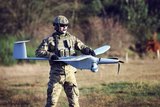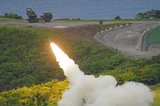Northrop Grumman's LEMV programme completes Critical Design Review
Six months after signing the Long Endurance Multi-Intelligence Vehicle (LEMV) agreement with the US Army to build three airships with 21-day persistent intelligence, surveillance and reconnaissance (ISR) capability, Northrop Grumman's LEMV programme team has completed its Critical Design Review (CDR). This is the fourth major milestone achieved by the programme since contract award.
"The entire US Army/Northrop Grumman LEMV industry team has done an outstanding job working through a very aggressive development schedule to achieve all of these important milestones. The CDR provided an in-depth review of the complete system design of the programme giving us the opportunity to assess where we are in our development and air vehicle production. It went very well," said Alan Metzger, Northrop Grumman vice president and integrated programme team leader of LEMV and airship programmes. "The entire team has been collaborating and remains very focused on meeting our objective of delivering this powerful capability into the hands of our combat commanders as soon as possible."
"There are three upcoming major milestones in the next 10 months," Metzger said, "We'll have hull inflation in the spring and first flight of the airship test article by mid-to-late summer. Upon completion of the development ground and flight testing phase, we expect to transition to a government facility and conduct our final acceptance long endurance flight just before year's end. In early 2012, LEMV will participate in an Army Joint Military Utility Assessment in an operational environment," he added. "As you can imagine, it's a very aggressive schedule to deliver from concept-to-combat in this time period."
Under the June 2010 agreement, awarded by the US Army Space and Missile Defense Command/Army Forces Strategic Command, Northrop Grumman will design, develop and test a long-duration hybrid airship system all within an 18-month time period.
"The power of the LEMV system is that its persistent surveillance capability is built around Northrop Grumman's open architecture design, which provides plug-and-play payload capability to the warfighter and room for mission growth," Metzger said. "The system rapidly accommodates next-generation sensors as emerging field requirements dictate and will provide increased operational utility to battlefield commanders. Today, our system readily integrates into the Army's existing Universal Ground Control Station and Deployable Common Ground System command centers and ground troops in forward operating bases.
"Beyond the value of seamless interoperability, the LEMV system provides a high level of fuel efficiency to the user community-a crucial part of life cycle logistics and support in theatre. While LEMV is longer than a football field and taller than a seven-story building, it utilizes approximately 3,500 gallons of fuel for the air vehicle to remain aloft for a 21-day period of service, that's approximately $11,000 at commercial prices," Metzger added.
Northrop Grumman's industry team includes Hybrid Air Vehicles, Ltd. of the United Kingdom, Warwick Mills, ILC Dover, AAI Corporation, SAIC and a team of technology leaders from 18 US states and three countries. In addition to leading the programme, Northrop Grumman leads the system integration, and flight and ground control operations for the unmanned vehicle to safely take off and land in worldwide operations.
Source: Northrop Grumman
More from Digital Battlespace
-
![Babcock nears first customer for Nomad AI translation tool]()
Babcock nears first customer for Nomad AI translation tool
Nomad can provide militaries with real-time intelligence, saving critical time on the battlefield.
-
![AUSA 2025: Israel’s Asio Technologies to supply hundreds of improved Taurus tactical systems]()
AUSA 2025: Israel’s Asio Technologies to supply hundreds of improved Taurus tactical systems
Taurus operates alongside the Israel Defense Forces’ Orion system which supports mission management across tens of thousands of manoeuvring forces, from squad leaders to battalion commanders.
-
![AUSA 2025: Kopin pushes micro-LED plans as China moves faster]()
AUSA 2025: Kopin pushes micro-LED plans as China moves faster
The plan for the new displays follows fresh investment in Kopin’s European facilities by Theon and an order for head-up displays in fielded aircraft, with funding from the US Department of Defense.
-
![AUSA 2025: Persistent Systems to complete its largest order by year’s end]()
AUSA 2025: Persistent Systems to complete its largest order by year’s end
Persistent Systems received its largest ever single order for its MPU5 devices and other systems earlier this month and has already delivered the 50 units to the US Army’s 4th Infantry Division.
-
![Aselsan brings in dozens of companies and systems under the Steel Dome umbrella]()
Aselsan brings in dozens of companies and systems under the Steel Dome umbrella
Turkey has joined the family of countries attempting to establish a multilayered air defence system with government approval in August 2024 for the effort landed by Aselsan. Dubbed Steel Dome, the programme joins Israel’s Iron Dome, the US Golden Dome, India’s Mission Sudarshan Chakra and South Korea’s low-altitude missile defence system.
-
![DSEI 2025: MARSS unveils new agnostic multidomain C4 system]()
DSEI 2025: MARSS unveils new agnostic multidomain C4 system
MARSS’ NiDAR system has been deployed using sensors from static platforms to provide detection and protection for static sights, such as critical infrastructure, ports and military bases.




























